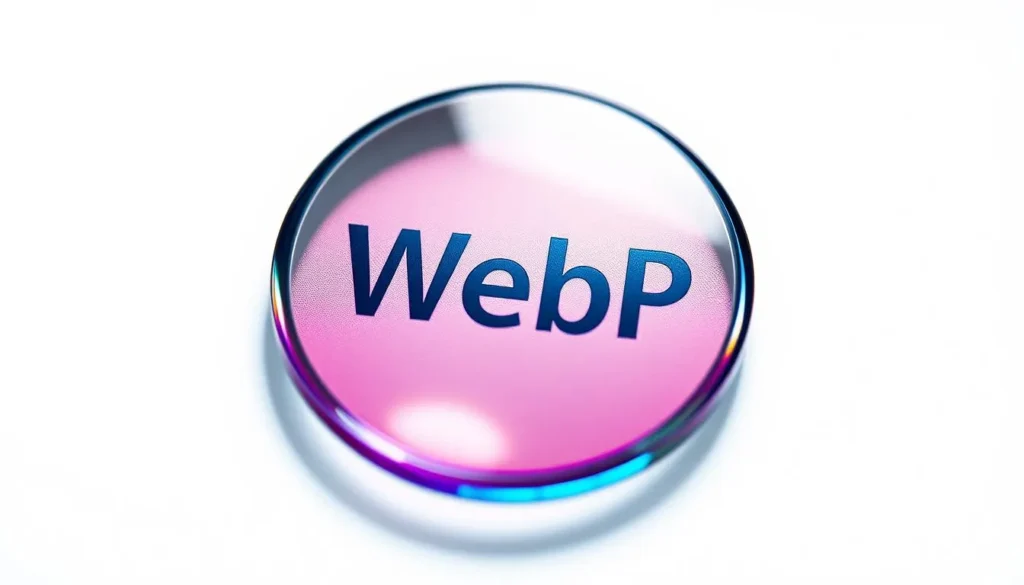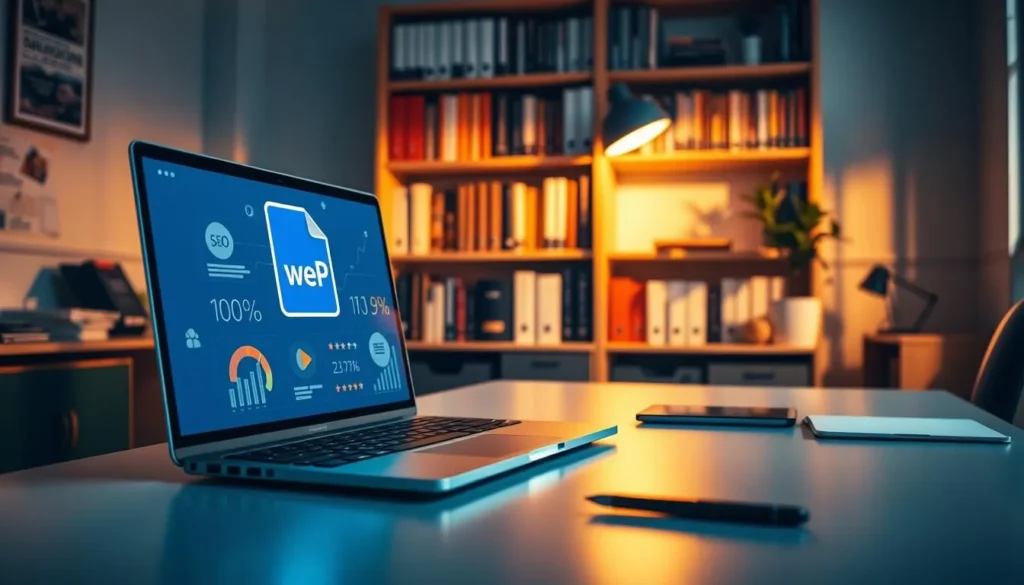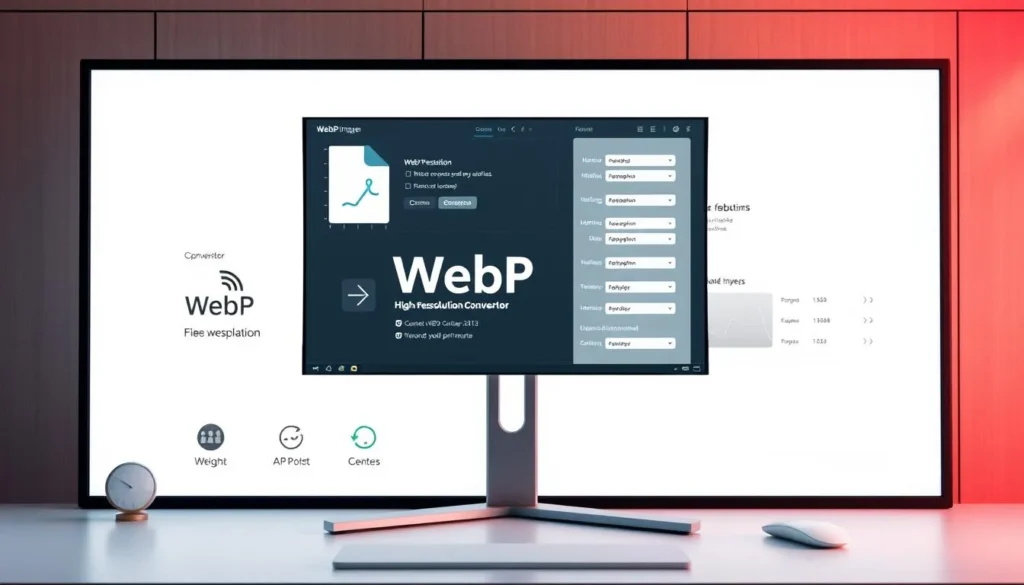Modern websites require optimal image compression to ensure fast loading times and a seamless user experience. One format that has gained popularity in recent years is WebP, which offers superior compression and image quality compared to traditional formats like JPG.

The need for efficient image formats has become increasingly important as websites continue to evolve. With the rise of high-quality visuals, it’s crucial to adopt formats that can handle these demands without sacrificing performance.
By adopting WebP, websites can significantly enhance their performance and user experience. This is particularly important for businesses operating in the United States, where a fast and responsive website can be a key differentiator.
Key Takeaways
- WebP offers better compression than JPG, resulting in faster loading times.
- The adoption of WebP can significantly enhance website performance.
- Using a jpg to webp converter can simplify the process of transitioning to WebP.
- WebP supports both lossy and lossless compression, making it versatile.
- Improved website performance can lead to a better user experience.
Understanding Image Formats in Web Development
Web development has witnessed a considerable shift in how images are handled and optimized. As websites strive for faster load times and better user experiences, the choice of image format plays a crucial role.
The Evolution of Web Images
Over the years, image formats have evolved to meet the demands of web development. From the early days of GIF and JPG to the more recent introduction of formats like WebP, the goal has been to achieve better compression and image quality.
The Importance of Optimized Images for Websites
Optimized images are crucial for website performance. They not only improve load times but also enhance the overall user experience. Using formats like WebP and tools such as a webp converter can significantly reduce file sizes without compromising on quality.
- Faster page loads
- Improved user experience
- Better search engine rankings
By understanding the evolution of image formats and the importance of optimization, web developers can make informed decisions about their image strategies.
What Is WebP and How Does It Work?
WebP has emerged as a game-changer in the realm of web images, offering a more efficient alternative to traditional formats like JPG. Developed by Google, WebP is designed to provide superior compression and image quality, making it an ideal choice for modern websites.
The Origin and Development of WebP
WebP was first introduced by Google in 2010 as part of its initiative to speed up the web. The format is based on the VP8 video codec, which was used to compress images. This innovative approach allowed WebP to achieve significant reductions in file size while maintaining image quality.
“WebP is a modern image format that provides superior compression and image quality. It’s designed to help web developers optimize their websites for faster loading times and better user experience.” – Google Developers
Technical Foundations of WebP Format
WebP’s technical superiority lies in its ability to use both lossy and lossless compression techniques. This flexibility allows WebP to handle a wide range of images, from photographs to graphics. The format also supports transparency and animation, making it a versatile choice for web developers.
| Feature | WebP | JPG |
| Compression Type | Lossy & Lossless | Lossy |
| Transparency Support | Yes | No |
By understanding the technical foundations of WebP, developers can leverage its capabilities to enhance website performance and user experience.
Traditional JPG Format: Strengths and Limitations
JPG has long been the standard for web images, but its limitations are becoming apparent. As web design continues to evolve, understanding the strengths and weaknesses of JPG is crucial for optimizing website performance.
How JPG Compression Works
JPG uses a lossy compression method, which reduces file size by discarding some of the image data. This process can lead to a decrease in image quality, especially if the compression level is too high. However, JPG’s compression algorithm is designed to minimize the perceived loss in quality by prioritizing the retention of important visual information.
Where JPG Falls Short in Modern Web Design
Despite its widespread use, JPG has several limitations. It lacks support for transparency, which is a significant drawback for modern web design that often incorporates complex graphics and overlays. Moreover, JPG’s compression method can lead to artifacts and a loss of detail in images.
Key limitations of JPG include:
- Lack of transparency support
- Lossy compression leading to artifacts
- Limited color depth compared to newer formats
As noted by experts, “The limitations of JPG are driving the adoption of newer image formats like WebP, which offer better compression and more features.” Using a jpg to webp converter can help mitigate some of JPG’s limitations by converting images to a more efficient format.
WebP vs. JPG: A Comprehensive Comparison
In the quest for optimal website performance, understanding the differences between WebP and JPG is crucial. Both formats have their own set of advantages and disadvantages, and making an informed decision requires a deep dive into their characteristics.
File Size Differences
One of the most significant advantages of WebP over JPG is its ability to compress images to smaller file sizes without compromising quality. WebP’s compression algorithm is more efficient, resulting in files that are significantly smaller than their JPG counterparts. This reduction in file size translates to faster load times and improved website performance.
Image Quality Comparison
When it comes to image quality, both WebP and JPG have their strengths. JPG is known for its ability to compress images with minimal loss of quality, making it a popular choice for photographic images. However, WebP’s advanced compression techniques allow it to achieve similar or even better quality at lower file sizes. This makes WebP an attractive option for websites looking to optimize their images without sacrificing visual fidelity.
Color Depth and Transparency Support
WebP has a significant edge over JPG when it comes to color depth and transparency support. While JPG is limited to 24-bit color depth, WebP supports both 24-bit and 32-bit color depths, allowing for more nuanced color representation. Additionally, WebP supports transparency, making it ideal for graphics and logos that require a transparent background. This feature is particularly useful for websites that need to overlay images or create complex visual effects.
In conclusion, the comparison between WebP and JPG reveals that WebP offers several key advantages, including smaller file sizes, comparable or superior image quality, and enhanced color depth and transparency support. As the web continues to evolve, adopting WebP can be a strategic move for websites aiming to improve performance and user experience.
Why WebP Delivers Superior Performance for Websites
WebP is revolutionizing the way websites load images, offering a significant boost in performance. By adopting WebP, websites can achieve substantial improvements in load times, bandwidth savings, and overall user experience.
Load Time Improvements
One of the primary advantages of WebP is its ability to reduce image file sizes significantly. This reduction leads to faster load times, as less data needs to be transferred over the network. With the average user expecting a website to load in under three seconds, using WebP can be a crucial step in meeting this expectation.
Bandwidth Savings
Smaller image files mean less bandwidth consumption, which is particularly beneficial for users on limited data plans or in areas with slow internet connectivity. By saving bandwidth, websites can also reduce their hosting costs and improve overall efficiency.
Impact on Core Web Vitals
Core Web Vitals are a set of metrics that Google uses to evaluate the user experience of a webpage. WebP’s ability to reduce load times directly impacts these metrics, particularly Largest Contentful Paint (LCP). By optimizing images with WebP, websites can improve their LCP scores, leading to better search engine rankings and a more satisfying user experience.
Utilizing a webp converter can simplify the process of transitioning to WebP, allowing web developers to easily optimize their images without compromising on quality.
SEO Advantages of Using WebP Images
WebP images offer a compelling advantage in search engine optimization due to their superior compression capabilities. By reducing the file size of images, WebP can significantly improve a website’s load time, a critical factor in search engine rankings.
How Image Optimization Affects Search Rankings
Optimizing images is a crucial aspect of SEO. Search engines like Google prioritize websites that load quickly and efficiently. By using WebP, websites can reduce their image file sizes, leading to faster load times and potentially higher search rankings.

Google’s Preference for WebP
Google has explicitly recommended the use of WebP for image compression due to its ability to provide superior compression efficiency. This preference is reflected in Google’s search algorithms, which favor websites that utilize WebP for their images.
Case Studies: SEO Improvements After WebP Implementation
Several case studies have demonstrated the SEO benefits of implementing WebP. For instance, a study by Google found that using WebP resulted in significant reductions in page load times, leading to improved user experience and search engine rankings.
| Website Type | Load Time Reduction | SEO Improvement |
| E-commerce | 30% | Improved search rankings for product pages |
| Media Sites | 25% | Better image indexing and visibility |
As these case studies illustrate, adopting WebP can be a strategic move for websites aiming to enhance their SEO and stay competitive in search engine results.
Browser Compatibility and Support for WebP
With WebP offering significant advantages over traditional formats, assessing browser compatibility is essential. As the web continues to evolve, understanding how different browsers support WebP is crucial for developers and website owners alike.
Current Browser Support Status
Most modern browsers have adopted WebP, making it a viable option for web images. However, the level of support can vary. Major browsers like Google Chrome, Mozilla Firefox, and Microsoft Edge have full support for WebP. In contrast, Safari has partial support, and older versions of Internet Explorer do not support WebP at all.
| Browser | WebP Support |
| Google Chrome | Full Support |
| Mozilla Firefox | Full Support |
| Microsoft Edge | Full Support |
| Safari | Partial Support |
| Internet Explorer | No Support |
Fallback Strategies for Older Browsers
For browsers that don’t support WebP, using a jpg to webp converter can help create fallback images in JPG or PNG format. This ensures that all users can view your website’s images, regardless of their browser’s capabilities.
Top WebP Converter Tools for Optimizing Your Images
Converting images to WebP format is now a necessity for modern websites, and there are numerous tools available to facilitate this process. The right WebP converter can simplify the optimization process, ensuring that your images are both high-quality and compressed for the web.
Online JPG to WebP Converters
For those looking for a quick and easy solution, online converters are a great starting point. Tools like CloudConvert and Convertertoolskit allow users to upload their images and download them in WebP format. These services are convenient and often free, making them ideal for small-scale conversions.
Desktop Applications for WebP Conversion
Desktop applications offer more control and flexibility for converting images to WebP. Programs like XnConvert and IrfanView support batch processing, allowing users to convert multiple images at once. This is particularly useful for websites with large image libraries.
Command Line and Developer Tools
For developers, command-line tools like cwebp provide a powerful solution for converting images to WebP. This tool, part of Google’s WebP package, offers advanced options for compression and quality control.
Batch Processing Options
Batch processing is a crucial feature for efficiently converting large numbers of images. Tools like XnConvert and command-line scripts using cwebp support this functionality, saving time and effort.
Automation Solutions
For ongoing image optimization, automation is key. Integrating WebP conversion into your development workflow can be achieved through scripts and automated build processes, ensuring that new images are optimized as they’re added to your site.
| Tool | Type | Batch Processing |
| CloudConvert | Online | Yes |
| XnConvert | Desktop | Yes |
| cwebp | Command Line | Yes |

Implementing WebP on Your Website
To take full advantage of WebP’s benefits, understanding how to implement it on your website is crucial. WebP offers superior compression and quality compared to traditional image formats like JPG.
HTML Implementation Techniques
One way to implement WebP is by using the <picture> element in HTML, which allows you to specify multiple image sources, including WebP, for different browsers.
For example:
<picture>
<source srcset="image.webp" type="image/webp">
<img src="image.jpg" alt="FallbackImage">
</picture>Using Content Delivery Networks (CDNs) with WebP
CDNs can automatically optimize and deliver WebP images to supported browsers, simplifying the implementation process.
“CDNs play a crucial role in optimizing WebP delivery, ensuring faster load times and improved user experience.”
WordPress and CMS Integration
For WordPress users, several plugins can automatically convert and serve WebP images.
Popular WebP Plugins
- WebP Converter for Media
- Optimole
- ShortPixel Image Optimizer
Custom Implementation Methods
For developers, custom implementation involves modifying server configurations to serve WebP images.
For instance, Apache servers can use mod_rewrite rules to serve WebP when supported.
Real-World Success Stories: WebP Implementation
By switching to WebP, many websites have achieved notable gains in load times and user experience. This section highlights real-world examples of how different types of websites have benefited from adopting WebP.
E-commerce Performance Improvements
E-commerce sites, known for their heavy image content, have seen significant improvements after converting their images to WebP using a reliable jpg to webp converter. For instance, online retailers have reported faster page loads and reduced bounce rates.
| E-commerce Platform | Load Time Reduction | Conversion Rate Impact |
| Online Fashion Store | 30% | +5% |
| Electronics Marketplace | 25% | +3% |
Media Sites and Content-Heavy Platforms
Media sites and content-heavy platforms have also benefited from WebP. By reducing image file sizes, these sites have improved their overall performance and user engagement.
Mobile Web Applications
For mobile web applications, the adoption of WebP has led to faster load times and a smoother user experience, even on slower networks. This is particularly beneficial for users in regions with limited internet connectivity.
In conclusion, the implementation of WebP has shown tangible benefits across various types of websites, from e-commerce to media sites and mobile web applications. By leveraging tools like a jpg to webp converter, website owners can significantly enhance their site’s performance.
Conclusion: Embracing WebP for Future-Ready Websites
As we’ve explored throughout this article, WebP offers significant advantages over traditional image formats like JPG. By adopting WebP, you can improve your website’s load times, reduce bandwidth consumption, and enhance overall user experience. To start leveraging these benefits, consider using a reliable webp converter to optimize your images.
With the majority of modern browsers supporting WebP, the barriers to adoption are continually decreasing. Implementing WebP on your website can be straightforward, whether you’re using HTML implementation techniques, content delivery networks (CDNs), or integrating it with your Content Management System (CMS) like WordPress.
As the web continues to evolve, embracing formats like WebP is crucial for staying ahead. By optimizing your website with WebP images, you’re not only improving your site’s performance but also enhancing your SEO standings. Take the first step towards a faster, more efficient website by integrating WebP into your web development strategy.
FAQ
What is WebP and how does it differ from JPG?
WebP is an image file format developed by Google that provides better compression than JPG, resulting in smaller file sizes while maintaining image quality. It supports both lossy and lossless compression, making it versatile for various web applications.
How do I convert JPG images to WebP?
You can convert JPG images to WebP using online jpg to WebP converters, desktop applications, or command-line tools. There are various WebP converter tools available that make this process straightforward, including batch processing options for converting multiple images at once.
Is WebP supported by all browsers?
Most modern browsers support WebP, including Google Chrome, Mozilla Firefox, and Microsoft Edge. However, older browsers may not support WebP. To ensure compatibility, you can implement fallback strategies, such as providing JPG or PNG alternatives for browsers that don’t support WebP.
Will using WebP improve my website’s SEO?
Yes, using WebP can improve your website’s SEO. Google prefers WebP due to its better compression and image quality. By optimizing your images with WebP, you can potentially boost your search engine rankings, as page load times and image optimization are factors in SEO.
How do I implement WebP on my WordPress website?
Implementing WebP on a WordPress website can be done using popular WebP plugins that convert and serve WebP images. These plugins often provide options for fallback strategies and can be easily integrated into your existing WordPress setup, making it simple to leverage the benefits of WebP.
Can I use WebP with Content Delivery Networks (CDNs)?
Yes, you can use WebP with CDNs. Many CDNs support WebP and can help optimize image delivery by serving WebP images to supported browsers, further enhancing your website’s performance and user experience.
